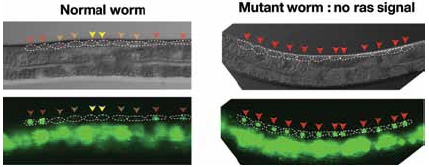Main Second Level Navigation
Andrew Fraser
PhD

Qualification
- University of Cambridge, Gurdon Institute, U.K., Research Fellow, 1999-2003.
- Cold Spring Harbor Laboratory, Cold Spring Harbor, NY, U.S., Research Fellow, 1997-1999.
- Imperial Cancer Research Fund, London, U.K., PhD in cancer biology, 1993-1997.
- University of Cambridge,U.K., BA in Biochemistry and Molecular Biology, 1990-1993.
MY RESEARCH OVERVIEW (GO TO SCIENTIFIC OVERVIEW)
The worm — a simpler, more elegant human
In any bar, if I tell people that I work on worms their eyes glaze over. When I say I’ve been doing that for ten years and more, I get looks of pity. If I ever go on to say that I think worms are totally cool, like humans only simpler and easier, then people edge away quietly leaving me alone with my beer. So why do I work on this tiny animal?

I work on worms because I like simple, stripped-down models that I can play with easily. The worm is very basic — each adult has only 959 cells and we know every cell division that occurs during its development. Despite its simplicity of form, the worm is genetically complex — the worm has 20,000 genes, half of which have very close matches in humans. So here’s the problem: we know all the genes and we know the whole of development — what does each gene do and how do they all cooperate to make a correct functioning animal? And here’s the magic — using a technique called RNAi, we can switch off any one of the worm’s genes at any stage of development and look at the effect on the animal. RNAi is miraculously easy to carry out, and so we can play with the worm simply and quickly, taking out the 20,000 genes one by one and looking at the effects.
Ultimately, fun as it is to mess around with worms, what we care about is humans. The central question that interests us is this — if you knew your entire genome sequence, what would it tell you? Can you predict your chances of getting bowel cancer, or of having an adverse reaction to a drug? At present, the answer is an emphatic no. How does our work in the worm help with this problem? In the worm, since we can use RNAi to remove each gene in turn and see the precise effect on the ‘health’ of the worm, we can begin to learn how to predict how inherited mutations will affect health in humans. We study not only how to predict the effect of removing any individual gene (which we can now do with surprising accuracy), but also the effect of removing combinations of genes. Since there are ~3million differences between any human genomes, knowing how multiple mutations combine to affect our health and risk of disease is one of the major problems in modern genetics.
SCIENTIFIC RESEARCH OVERVIEW
Mendelian disorders like cystic fibrosis and sickle cell anaemia are the best understood human genetic diseases. They are genetically very simple — the inheritance of a single mutated gene causes each disorder. We now know many hundreds of these disease-causing mutations — each mutation is rare, and each causes a single specific disorder, but together they make a major impact on human disease. At first sight, Mendelian disorders are hard to tackle — different genes are mutated in different disorders and each disorder is rare. How can we deal with all this genetic variation and all these rare disorders?
We want to understand the basic principles underlying ALL Mendelian disorders rather than dissect any single one exhaustively. In particular we are interested in one common feature of all Mendelian disorders — that while two people inheriting an identical mutation get the same disorder, they often have very different severity of symptoms. This range of symptoms can be extreme — one person can die yet another with the same genetic error can be almost completely healthy. If we can learn what is the genetic basis for the differences in severity of Mendelian disorders between any two people, we can give much more accurate and personalized diagnoses and also potentially develop new therapies aimed at regulating severity.
Our approach to this complex problem is to try to solve it in a simple system — the nematode worm C.elegans. The genetic tools in the worm are extremely powerful and the biology of the worm is almost completely defined. We can knock down, knock out, or mutate any gene in any individual worm and quantify precise effects on phenotype using assays that we have built. In broadest outline, if we could understand what determines the severity of a worm ‘Mendelian disorder’, we could apply these insights to human Mendelian disorders. We have already done a major project comparing mutant phenotypes of 1400 genes between two individuals using RNA-mediated interference (RNAi) and this study identified key effects of natural variation in gene expression on mutant phenotypes. In the future, we intend to extend this to a further 10 individuals using CRISPR-based approaches, RNAi screening and drug based screening. In addition, we will map many of the variants that affect the severity of genetic disorders in the worm. Together, this will be the first comprehensive view of how the same genetic perturbation can differ between individuals for any species and we are collaborating with several clinical and human genomics groups to take our findings into human samples.
Our programme to use the power of systematic genetics in C. elegans to understand the basic principles underlying human Mendelian disorders combines quantitative biology, computational biology, and human genetics. We believe it addresses one of the most fundamental aspects of human genetic disease — not to identify which mutations affect the health of humans in general, but to understand the effect of any mutation on a single affected human.
SELECT PUBLICATIONS
- Natural Variation in Gene Expression Modulates the Severity of Mutant Phenotypes. Vu V, Verster AJ, Schertzberg M, Chuluunbaatar T, Spensley M, Pajkic D, Hart GT, Moffat J, Fraser AG. Cell. 2015 Jul 16;162(2):391-402.
- The majority of animal genes are required for wild-type fitness. Ramani AK, Chuluunbaatar T, Verster AJ, Na H, Vu V, Pelte N, Wannissorn N, Jiao A, Fraser AG. Cell. 2012 Feb 17;148(4):792-802.
Comparative RNAi screens in C. elegans and C. briggsae reveal the impact of developmental system drift on gene function. Verster AJ, Ramani AK, McKay SJ, Fraser AG. PLoS Genet. 2014 Feb 6.
